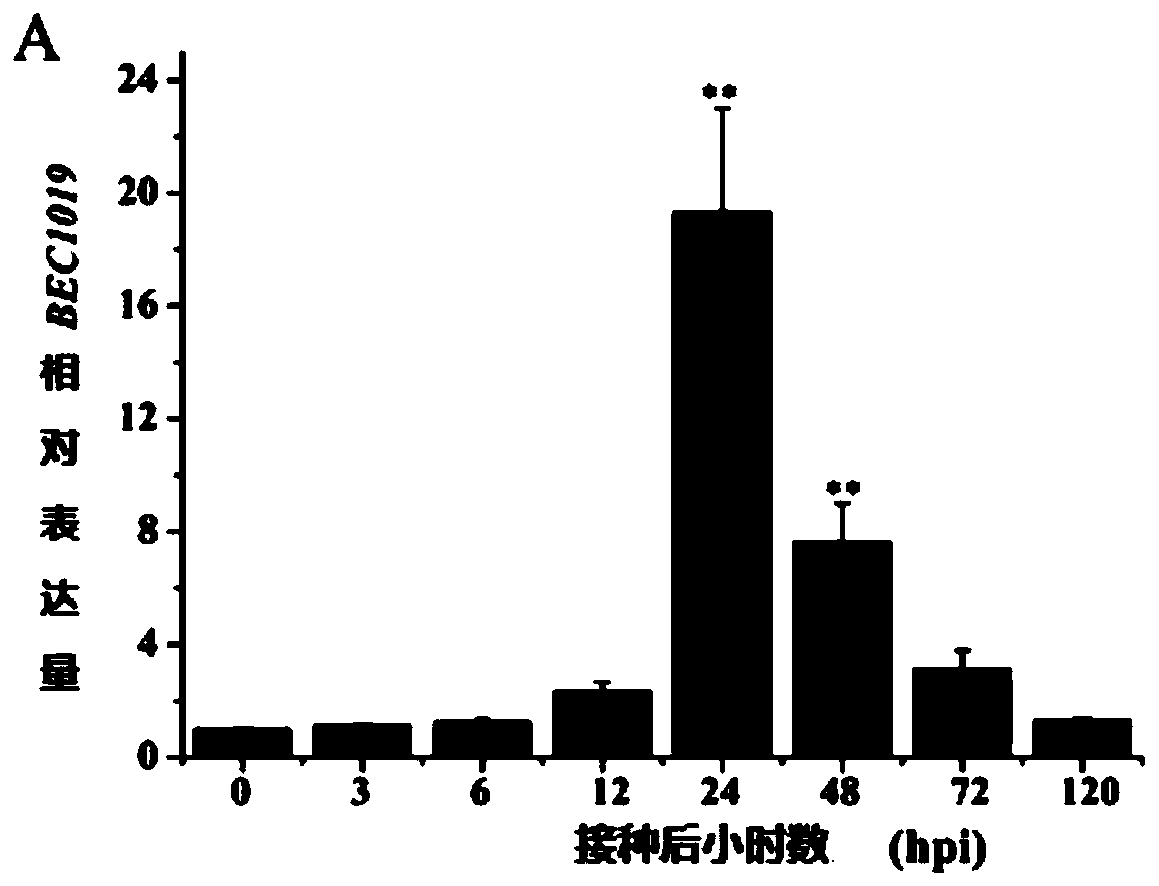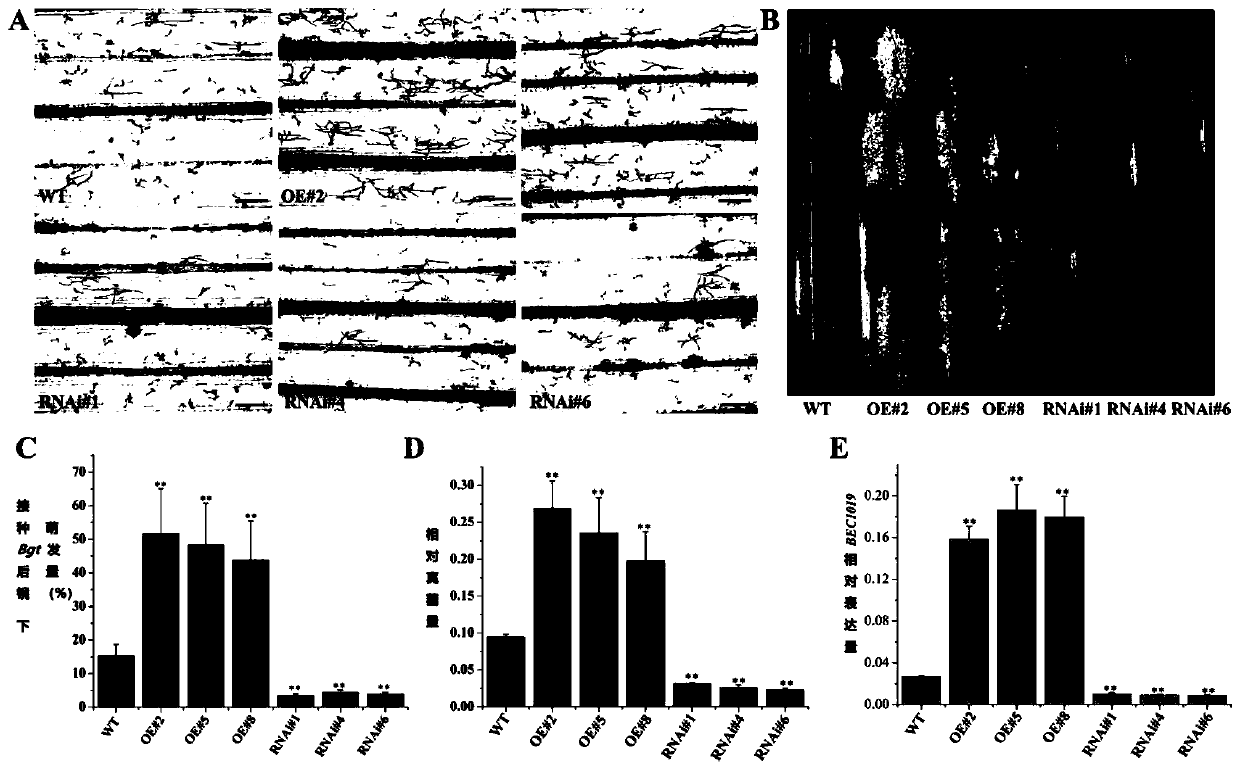Application of gene BEC1019 in improving resistance to powdery mildew of wheat
A technology of BEC1019 and wheat powdery mildew, applied in the field of agricultural biology, can solve the problems of lower ear formation rate, damage to photosynthesis, and aggravate leaf transpiration, so as to achieve the effect of enhancing disease resistance
- Summary
- Abstract
- Description
- Claims
- Application Information
AI Technical Summary
Problems solved by technology
Method used
Image
Examples
Embodiment 1
[0030] Cloning of Example 1 BEC1019 Gene Homologous Sequence
[0031] Take 4-5 pieces of wheat leaves infected with powdery mildew for 7 days, grind them fully with liquid nitrogen, extract the DNA of the pathogenic bacteria in a pre-cooled mortar, design primers, amplify the BEC1019 homologous gene of powdery mildew of wheat, and perform PCR reaction System (50 μL): 2×Easy pfu Mix 25 μL, fungal DNA template 2 μL, each primer 1 μL, ddH 2 O 21 μL, PCR reaction conditions: pre-denaturation at 95°C for 5 min; denaturation at 95°C for 30 s, annealing at 58°C for 30 s, extension at 72°C for 30 s, 35 cycles; extension at 72°C for 5 min, and storage at 4°C for later use.
[0032] The primer sequences are as follows:
[0033] BEC1019-F: 5'-ATGCAGTCTGTATTGCTTTT-3',
[0034] BEC1019-R: 5'-CTAGACACAATGAACCTCGC-3'.
[0035] After the fragments were detected by electrophoresis and purified, 4 μL of PCR products were taken respectively, added to 1 μL of pEASY-Blunt cloning vector, and re...
Embodiment 2
[0036] Example 2 Obtaining BEC1019 Overexpression and Silenced Transgenic Plants
[0037] Using Gateway technology, first construct the full-length and 265bp fragments (368-632bp) of the BEC1019 gene into the intermediate vector pDONR207, and the primer sequences are as follows:
[0038] F:
[0039] 5'-GGGGACAAGTTTGTACAAAAAAGCAGGCTTCGTGATGACCCGGACAAAA-3'R:
[0040] 5'-GGGGACCACTTTGTACAAGAAAGCTGGGTAGGGCATCTTGGTAACCA-3'.
[0041] The PCR reaction system is (5 μL): 3.5 μL of PCR recovered product, 1 μL of pDONR207 plasmid, BP Clonase TM II Enzyme Mix (Invitrogen) 0.5 μL. After mixing evenly, react in a low-temperature constant temperature tank at 25°C for 1 to 3 hours; then transfer it into competent cells E.coli DH5α, apply it on LB medium containing gentamicin after transformation, grow overnight at 37°C, and pick The single clones were cultured in liquid LB medium containing gentamicin, and the positive clones were sequenced after extracting the plasmids to obtain recombin...
Embodiment 3
[0046] Embodiment 3 analyzes the expression pattern of BEC1019 gene in powdery mildew (Bgt)
[0047] Eight time points of 0, 3, 6, 12, 24, 48, 72 and 120 hours after powdery mildew infection of wild-type dwarf kang 58 wheat leaves were selected, and RNA was extracted from plant tissues at different time points above to synthesize first-strand cDNA. The EF-1α (elongation factor-1α) gene of wheat powdery mildew was used to analyze the expression level of BEC1019 gene. Quantitative PCR, three simultaneous amplification and detection of each template in each quantitative experiment, and three biological repetitions, the primer sequences are as follows:
[0048] EF1α-F: 5'-GTCGGATTTAACCCCAAGGT-3',
[0049] EF1α-R: 5'-TTTATCGGTAGGGCGACTTG-3';
[0050] BEC1019-F: 5'-TCATGTGGACATCGTCGGTC-3',
[0051] BEC1019-R: 5'-CACGCTGATGTCAAACGCAT-3'.
[0052] Expression analysis of wheat leaves infected by powdery mildew at different time points, the results are as follows figure 1 As shown,...
PUM
 Login to view more
Login to view more Abstract
Description
Claims
Application Information
 Login to view more
Login to view more - R&D Engineer
- R&D Manager
- IP Professional
- Industry Leading Data Capabilities
- Powerful AI technology
- Patent DNA Extraction
Browse by: Latest US Patents, China's latest patents, Technical Efficacy Thesaurus, Application Domain, Technology Topic.
© 2024 PatSnap. All rights reserved.Legal|Privacy policy|Modern Slavery Act Transparency Statement|Sitemap



